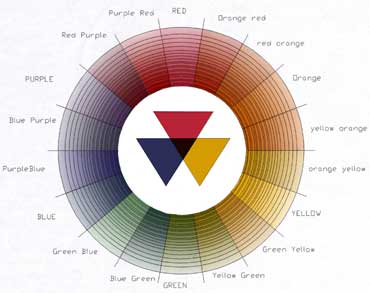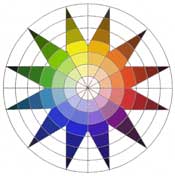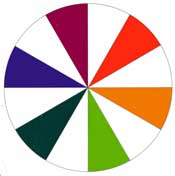Primary, Secondary and Tertiary Colors
The scientist and naturalist Moses Harris created the first color wheel to classify red, blue and yellow as the three primary colors.
This was in 1766, just a hundred years after Newton’s discovery.
Moses worked with pigments rather than lights following a discovery by a French painter that all hues could be reduced to mixtures of red, yellow and blue pigments. He developed and illustrated his theory.

Picture Above – Moses Harris, the first color wheel to classify red, blue and yellow as the three primary colors.
In the centre, the three pigment primaries (primitives) red, yellow and blue from which all colors could theoretically be mixed. He then derived the secondary (compound) hues orange, purple, and green. The mixture of primitives and compounds provided two intermediate stages. This created 18 colors; these were then graded into shades (darker values, which he created by optically mixing more closely placed black lines) and tints (lighter values, normally created by adding white, but he showed wider spacing between the black lines).
His classification theory was widely accepted by artists by the mid 19th Century.
In the early 20th Century, the German painter, teacher and art theoretician Johannes Itten, expanded Harris’ theories and that of Phillip Otto Runge.
Runge had attempted a three-dimensional model of color using a sphere.
The pure hues were the equator; the central axis was a grey scale from black at the bottom to white at the top.
The colors were graded from black to the pure hue to white in seven steps. Theoretically, the intermediate mixtures were inside the sphere.
Itten adapted these theories and expanded them by opening up the sphere to form a 12-point star, showing white as the centre. This star included 12 colors (hues) – 3 primary, 3 secondary and 6 tertiary. He defines these by tone (light or dark) and saturation (depth of color).

Picture – Johannes Itten’s 12-point star, with white at the center. The colors are defined by tone and saturation.
The primary colors – red, yellow and blue cannot be created by mixing any other colors together.

Picture – The Primary Colors – red, yellow and blue.
The secondary colors are the result of mixing two of the primary colors together creating orange, green and violet.

Picture – The Secondary Colors – orange, green and violet.
The six tertiary colors are derived from mixing one primary and one secondary color together.

Picture – The Tertiary Colors – red-orange, yellow-orange, yellow-green, blue-green, blue-violet, red-violet.
Find More Knowledge on Color
Popular Color Schemes
Free Color Course
Color Articles
Color Information
Color Meanings
Color Schemes
Color Theory
Paint
